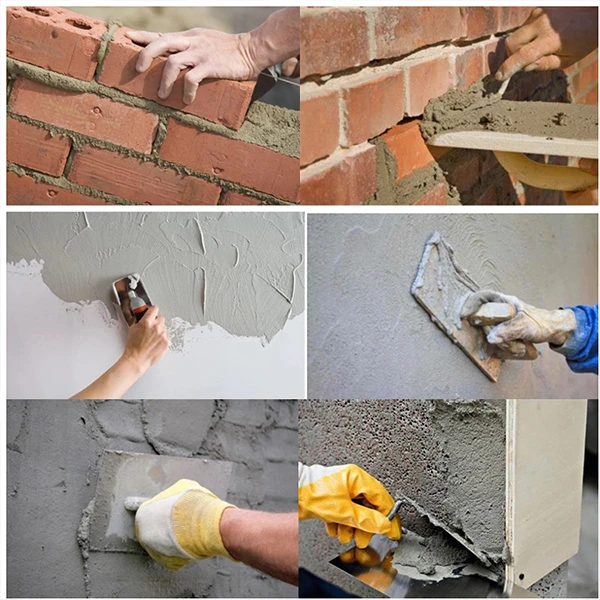HPMC for Tile Adhesive An Essential Component in Modern Construction
Hydroxypropyl Methylcellulose (HPMC) has emerged as a vital ingredient in the formulation of tile adhesives, known for its beneficial properties that enhance performance, usability, and durability. As the construction industry evolves, the demand for high-quality materials has placed HPMC at the forefront of tile adhesive development. This article delves into the importance of HPMC in tile adhesives, highlighting its functionality, advantages, and contribution to the overall performance of tile installation.
The Role of HPMC in Tile Adhesive
HPMC is a modified cellulose derivative, characterized by its water solubility and thickening properties. In tile adhesives, HPMC serves multiple functions
1. Water Retention One of the primary roles of HPMC is to improve water retention in tile adhesives. This property is crucial for maintaining moisture during the curing process, allowing for better adhesion of tiles to various substrates. Adequate water retention ensures that the adhesive remains wet longer, facilitating a stronger bond and reducing the risk of tile slippage.
2. Workability HPMC enhances the workability of tile adhesives, allowing for easier spreading and application. The improved consistency provided by HPMC makes it simpler for installers to achieve a uniform layer of adhesive, which is essential for proper tile alignment and placement.
3. Open Time The open time of an adhesive refers to the duration it remains workable after application. HPMC contributes to a longer open time, giving installers the flexibility to adjust tiles as needed before the adhesive sets. This is particularly important in larger projects where precision and accuracy are critical.
4. Thixotropic Properties The thixotropic nature of HPMC allows tile adhesives to have a gel-like consistency that becomes more fluid when disturbed. This property is beneficial during application, as it prevents the adhesive from sagging or flowing off vertical surfaces, ensuring that the tiles stay in place until the adhesive cures.
hpmc for tile adhes

Advantages of Using HPMC in Tile Adhesives
The incorporation of HPMC into tile adhesives offers numerous advantages that make it a preferred choice among manufacturers and installers
- Enhanced Bond Strength Tile adhesives formulated with HPMC exhibit superior adhesion to a wide range of substrates, including cement boards, plaster, and even specific types of tile, such as porcelain and granite. This enhanced bond strength leads to increased durability and longevity of the tile installation.
- Flexibility and Elasticity HPMC contributes to the flexibility and elasticity of tile adhesives, allowing them to accommodate slight movements in the substrate due to thermal expansion or settling. This flexibility helps prevent cracking and delamination of tiles over time, especially in areas subject to temperature fluctuations.
- Environmental Impact HPMC is derived from natural cellulose and is biodegradable, making it an environmentally friendly choice for tile adhesive formulations. As sustainability becomes a priority in construction, using eco-friendly materials like HPMC aligns with green building practices.
Conclusion
As the demand for high-performance tile adhesives continues to grow in the construction industry, HPMC stands out as a critical component that enhances functionality and application ease. Its properties not only improve water retention and workability but also contribute to the overall durability and strength of tile installations. By choosing tile adhesives formulated with HPMC, builders, contractors, and homeowners can achieve more reliable and longer-lasting results, ultimately leading to a more successful and satisfying tiling experience. Whether in residential or commercial projects, the benefits of HPMC in tile adhesives underscore its importance as a staple in modern construction materials.
-
Rdp Powder: Key Considerations for Wholesalers in the Building Materials IndustryNewsJul.08,2025
-
Key Considerations for Wholesalers: Navigating the World of Hpmc - Based ProductsNewsJul.08,2025
-
Hpmc Detergent: Key Considerations for WholesalersNewsJul.08,2025
-
Key Considerations for Wholesalers: China Hpmc For Tile Adhesive, Coating Additives, Concrete Additives, and MoreNewsJul.08,2025
-
Crucial Considerations for Wholesalers: Navigating the World of Construction MaterialsNewsJul.08,2025
-
Key Considerations for Wholesalers Sourcing Additive For Cement, Additive For Concrete, Additive For Putty from Additive Manufacturer Shijiazhuang Gaocheng District Yongfeng Cellulose Co., Ltd.NewsJul.08,2025




